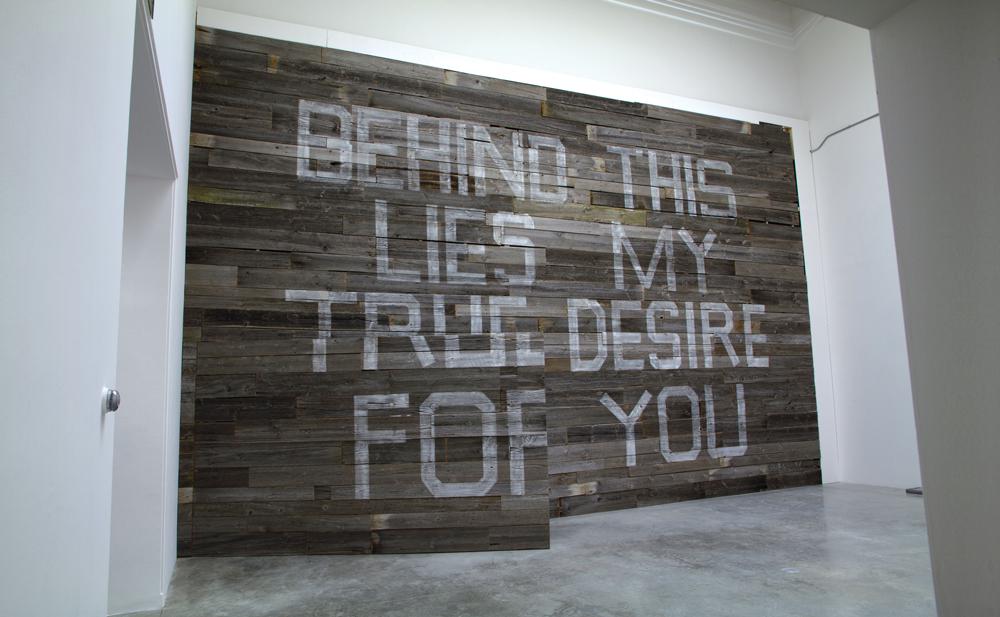Mark Clintberg’s recent exhibition “Do I still cross your mind?” resonates like an old love song; at once public and intensely intimate, it explores the interplay of desire, longing, anxiety, loss and mortality.
The first work viewers encounter in the gallery is Text mess age (2013): an eponymous blue-green neon sign that offers a somewhat sardonic reflection on our contemporary moment. It suggests the trouble of connecting in a world of abundant, immediate messaging that often offers little time for us to process, think and reflect. The work hints at the potential failings of our modes of communication, at our ease of forgetting and at our anxiety about being forgotten.
Adjacent to this, and bisecting the gallery, is Polaroid (2013), a monumental floor-to-ceiling curtain of diaphanous blue-green cotton. The work is a replica of Daniel Boudinet’s Polaroid photograph that serves as the frontispiece of Camera Lucida, Roland Barthes’s landmark reflection on photography—and mourning. This curtain is the cipher for Clintberg’s exhibition. It evokes Barthes’s punctum: the detail or “little hole” recognized in a photograph that metaphysically wounds the viewer. The punctum, discerned through the realms of memory and subjectivity, can be a visual element or, more salient here, a sense of time, beneath which we might perceive the spectre of death. Light streams through the deliberately woven tears in Clintberg’s curtain; the piece is shroud-like and funereal, yet somehow erotic: it both obscures and reveals.
Beyond the shroud, the gallery walls are dotted with a series of duotone prints of barbershop hair models, which Clintberg found and photographed through storefront windows. The reproduced images retain the sickly blueish hue of the original sun-faded, fly-stained photos. Replicated on fragile, curling newsprint, these decaying icons are evocative of a time that has passed, and the death of desire.
Gatekeeper to the exhibition’s final room is Behind this lies my true desire for you (2012), a wall of silvered reclaimed barn wood with its titular message written in huge whitewashed letters. This declaration, together with the wall’s ajar portal, seem like an invitation, a promise. From within throbs the muffled bass line of Quiet Disco (2013), a soundtrack redolent of a nearby party. The work’s affect is palpable: a familiar twist of the stomach, a sense of excitement for the potential of an evening spent sweating and moving with strangers, and underlying it all, the fear of missing out. Who wants to become one of the greyed, forgotten sentinels on the wall behind you?
Beyond the wall, there is no celebration. Instead, in a darkened room, Clintberg offers Frottage (2013): stacks of newsprint, stubs of graphite and two messages cast in bronze. Viewers are invited to produce and take with them a rubbing. The newsprint reveals one of two messages: “I have taken a rubbing of this & hung it in my window because I have forgotten you, even though you are still in love with me” or “I have taken a rubbing of this & hung it in my window because I am still in love with you, even though you have forgotten me.” Both provoke a creeping wound: either this will be, or this has been.
This is a review from the Fall 2013 issue of Canadian Art. To read more from this issue, visit its table of contents.

 Mark Clintberg Behind this lies my true desire for you 2012 Salvaged barnwood 7.01 x 9.44 m Courtesy the artist / photo Joe Kelly
Mark Clintberg Behind this lies my true desire for you 2012 Salvaged barnwood 7.01 x 9.44 m Courtesy the artist / photo Joe Kelly







